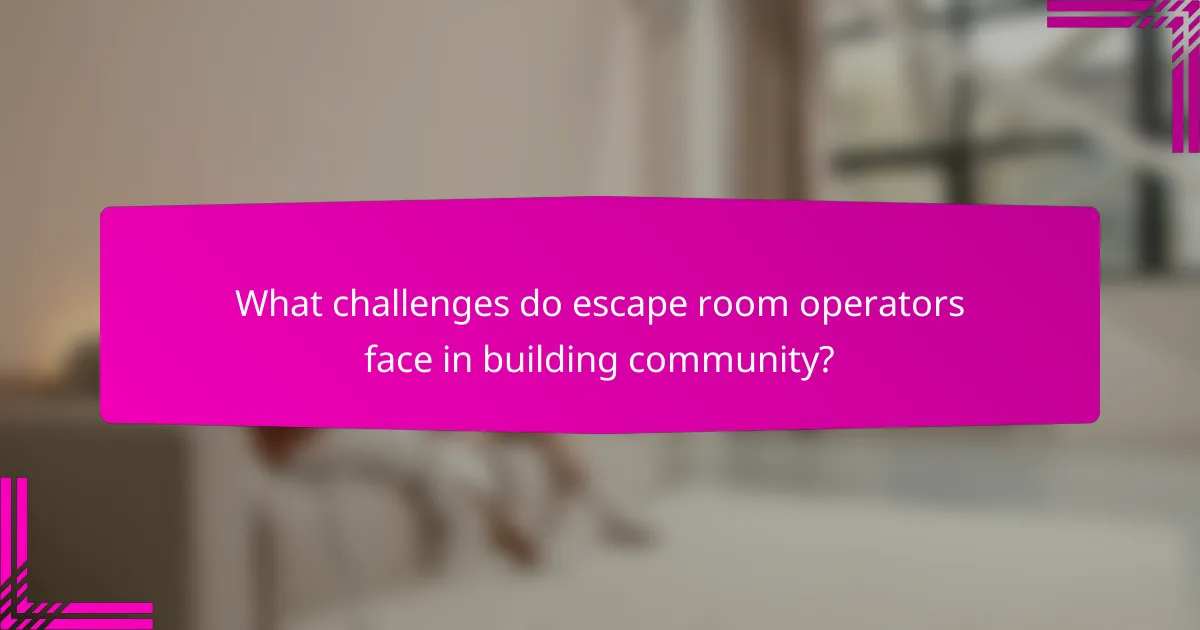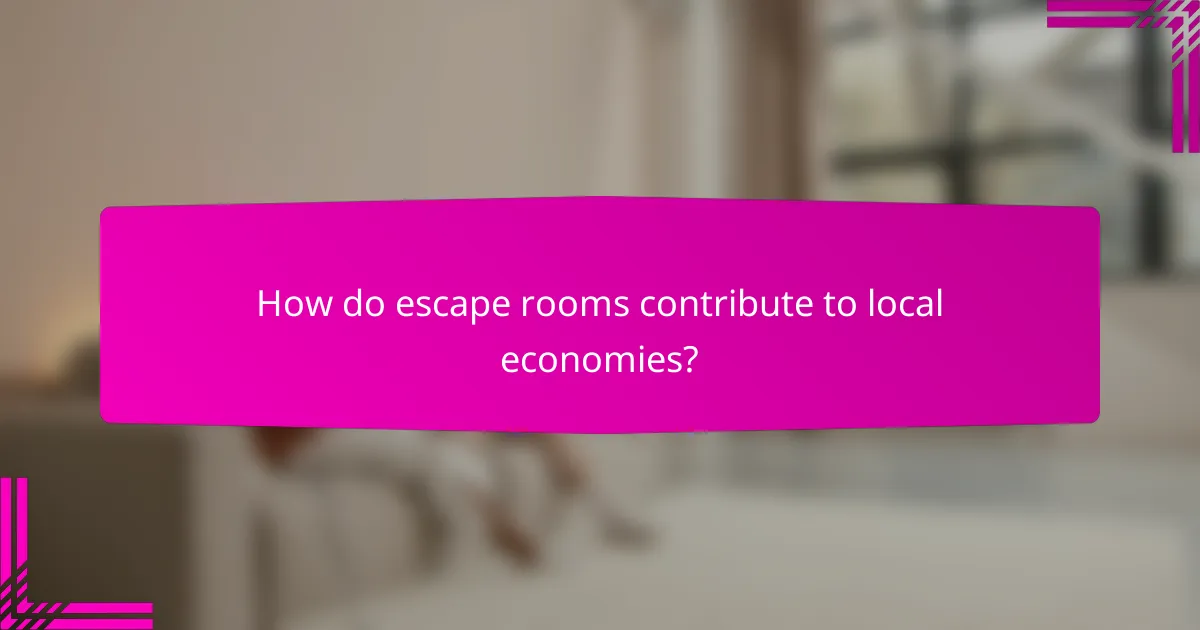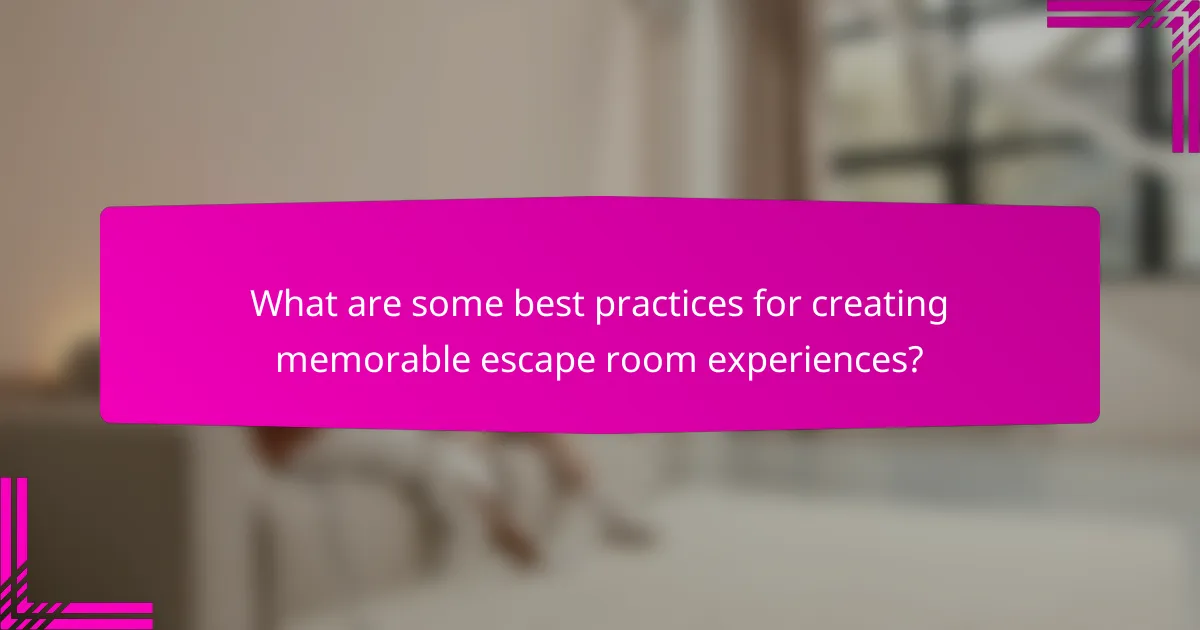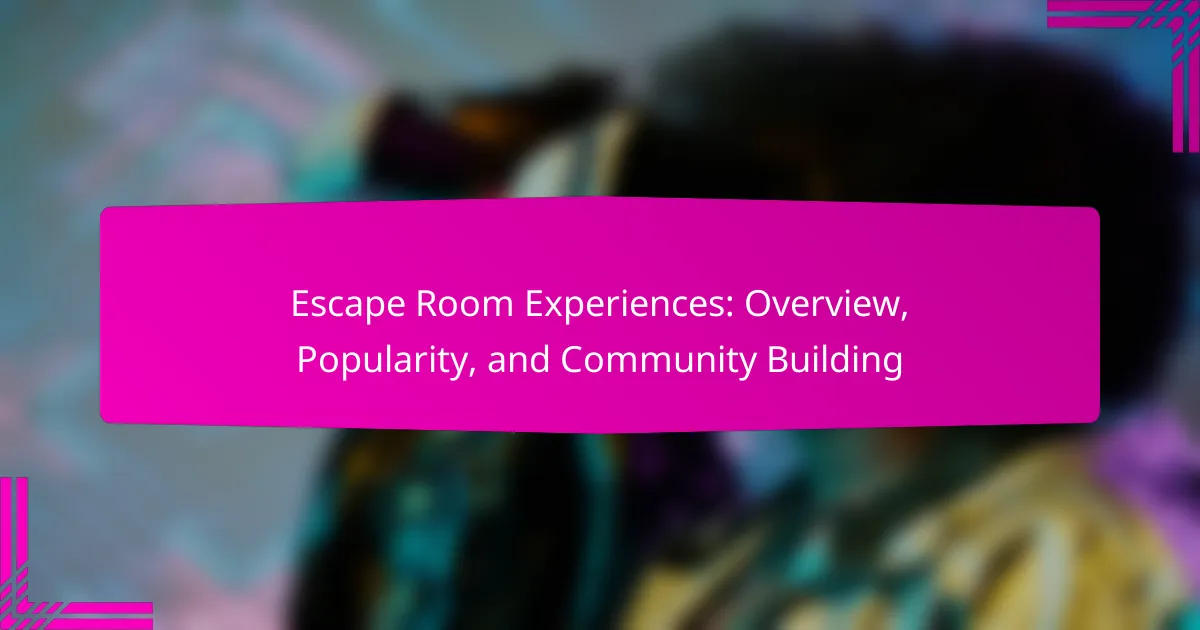Escape room experiences offer thrilling challenges that enhance teamwork and social interaction. Their popularity stems from immersive themes, innovative puzzles, and engaging storytelling. Community events and social media foster loyalty and connection among participants. Additionally, escape rooms contribute significantly to local economies by attracting visitors and generating revenue.

What drives the popularity of escape room experiences?
Escape room experiences are popular due to their immersive challenges and social interaction. Participants enjoy solving puzzles collaboratively, fostering teamwork and communication. The thrill of escaping within a time limit adds excitement. Additionally, unique themes and storylines attract diverse audiences, enhancing repeat visits. Community events and social media engagement further amplify interest, creating a vibrant culture around escape rooms.
How do escape rooms enhance social interaction among participants?
Escape rooms significantly enhance social interaction among participants by fostering teamwork and communication. Participants must collaborate closely to solve puzzles, which encourages dialogue and strengthens relationships. The immersive environment creates shared experiences, making it easier for individuals to bond over challenges. As a result, escape rooms serve as effective tools for community building and improving social skills.
Which demographic groups are most engaged with escape room activities?
Young adults and families are the most engaged demographic groups with escape room activities. Research indicates that individuals aged 18 to 34 often seek immersive experiences, while families value team-building and entertainment. Additionally, corporate groups participate for team bonding and problem-solving exercises. This diverse engagement fosters community connections and social interaction, making escape rooms popular across various age groups.
What role does word-of-mouth play in attracting new players?
Word-of-mouth significantly attracts new players to escape room experiences. Personal recommendations create trust and excitement, leading to higher participation rates.
Satisfied players share their experiences, often emphasizing unique attributes like immersive storytelling and teamwork challenges. This organic promotion fosters community building and enhances the popularity of escape rooms. As a result, venues benefit from increased bookings and a loyal customer base.

What are the core elements that define a successful escape room?
A successful escape room includes immersive themes, challenging puzzles, and effective storytelling. These core elements engage players and encourage teamwork. Unique attributes like innovative technology can enhance experiences. Effective room design also ensures smooth gameplay flow, contributing to overall satisfaction.
How do themes and narratives influence participant engagement?
Themes and narratives significantly enhance participant engagement in escape room experiences by creating immersive storylines. Engaging themes draw players into a narrative, fostering emotional connections and collaboration. This communal aspect enhances social interaction, making the experience memorable. Moreover, well-crafted narratives provide context and purpose, increasing motivation to solve puzzles and complete challenges.
What types of puzzles are most commonly used in escape rooms?
Escape rooms commonly use puzzles such as logic puzzles, physical challenges, riddles, and cryptography. These puzzles engage participants and enhance teamwork. Logic puzzles often require critical thinking, while physical challenges test agility. Riddles add a creative twist, and cryptography introduces problem-solving through codes. Each type contributes to the immersive experience of escape rooms.
How does the design of the physical space affect the overall experience?
The design of the physical space significantly enhances the overall escape room experience. A thoughtfully crafted environment immerses participants, stimulates interaction, and promotes problem-solving. Elements such as layout, lighting, and thematic decor create an engaging atmosphere. Unique attributes like hidden clues and interactive props further enrich the experience, making it memorable. Effective design fosters community building as players share their experiences and strategies, strengthening social connections.

What unique experiences do themed escape rooms offer?
Themed escape rooms offer immersive storytelling, unique puzzles, and interactive environments that enhance teamwork. Participants engage in role-playing scenarios, creating memorable experiences. These rooms often reflect popular culture themes, appealing to diverse interests. The unique design and challenges foster community bonding and social interaction.
How do seasonal or limited-time escape rooms create buzz?
Seasonal or limited-time escape rooms generate buzz by creating urgency and excitement among players. These experiences often feature unique themes and challenges that are available for a short period, attracting both new and returning customers.
The exclusivity of these events encourages word-of-mouth marketing and social media sharing, enhancing community engagement. Players are motivated to participate before the opportunity disappears, leading to increased bookings and heightened interest in the escape room industry.
Additionally, themed events can tie into local festivities or holidays, further amplifying their appeal. This strategic timing aligns with community events, fostering a sense of belonging and shared experience among participants.
What are some examples of escape rooms inspired by popular culture?
Escape rooms inspired by popular culture often feature themes from movies, TV shows, and video games. Examples include “Escape from the Haunted Mansion,” inspired by classic horror films, and “The Wizarding World,” based on the Harry Potter series. Other notable rooms are “The Walking Dead,” which immerses players in a post-apocalyptic scenario, and “Stranger Things,” where participants solve puzzles reminiscent of the show’s supernatural elements. These experiences leverage familiar narratives to enhance engagement and community interaction.

What challenges do escape room operators face in building community?
Escape room operators face several challenges in building community, including competition, engagement, and customer retention. High competition in the entertainment sector makes it difficult to stand out. Operators must create unique experiences to attract and retain customers. Engaging the community through events or collaborations can foster loyalty but requires resources and creativity. Additionally, maintaining consistent communication with customers is essential for building lasting relationships.
How can escape rooms foster loyalty among repeat customers?
Escape rooms foster loyalty among repeat customers by creating engaging and memorable experiences. They encourage teamwork and problem-solving, which enhances social bonds among players. Regularly updating challenges keeps the experience fresh, enticing customers to return. Additionally, loyalty programs and special events can further strengthen community ties and encourage repeat visits.
What strategies can be employed to create a welcoming environment?
To create a welcoming environment in escape room experiences, focus on fostering inclusivity and engagement. Start with friendly staff who greet participants warmly. Incorporate diverse themes that resonate with various audiences, enhancing relatability. Utilize comfortable seating and inviting decor to create an appealing atmosphere. Provide clear instructions and support to ensure everyone feels included and capable.

How do escape rooms contribute to local economies?
Escape rooms significantly boost local economies by attracting visitors and generating revenue. They create jobs, stimulate surrounding businesses, and enhance community engagement.
Escape rooms often draw tourists, increasing foot traffic in nearby shops and restaurants. This interaction supports local employment and promotes community cohesion.
Moreover, escape rooms contribute to the local economy by hosting events, parties, and corporate team-building activities. These gatherings further enhance the economic impact by encouraging group spending in the area.
In summary, escape rooms serve as economic catalysts, fostering growth and community connection while providing unique entertainment experiences.
What partnerships can escape room businesses form with local organizations?
Escape room businesses can form partnerships with local organizations such as schools, corporate entities, and community centers. These collaborations enhance marketing efforts and foster community engagement. Schools can organize field trips, while corporations might use escape rooms for team-building exercises. Community centers can host events, promoting local culture and attracting diverse audiences. Such partnerships create a mutually beneficial ecosystem that boosts visibility and strengthens community ties.
How do escape rooms attract tourism and visitors to a region?
Escape rooms attract tourism and visitors by offering unique, immersive experiences that encourage group participation. These activities promote social interaction and teamwork, appealing to families and friends seeking entertainment.
Additionally, escape rooms often integrate local themes or history, enhancing their appeal to tourists interested in regional culture. They can serve as a focal point for community events, drawing visitors and fostering local engagement.
The rise of social media also plays a role, as participants share their experiences online, creating buzz and attracting new customers. Overall, escape rooms contribute to the local economy by increasing foot traffic and encouraging spending in nearby businesses.

What are some best practices for creating memorable escape room experiences?
To create memorable escape room experiences, focus on immersive storytelling, innovative puzzles, and engaging themes. Incorporate sensory elements like sound and lighting to enhance the atmosphere. Regularly update challenges to keep returning players engaged. Foster a sense of community through events and feedback sessions.
How can feedback from participants improve future designs?
Feedback from participants significantly enhances future escape room designs by identifying strengths and weaknesses. This input helps creators refine puzzles, improve themes, and enhance overall experiences. Gathering insights through surveys or discussions allows designers to understand player preferences and engagement levels. As a result, incorporating this feedback leads to more enjoyable and immersive experiences, fostering community growth and loyalty.
What common mistakes should operators avoid when setting up their escape rooms?
Operators should avoid common mistakes like inadequate planning, unclear themes, and insufficient testing. Failing to define a clear narrative can confuse players, diminishing the experience. Additionally, neglecting safety protocols may lead to liability issues. Operators should also ensure puzzles are well-balanced in difficulty to maintain engagement. Finally, overlooking marketing strategies can limit visibility in a competitive market.
How can technology enhance the escape room experience?
Technology enhances the escape room experience by integrating immersive elements, interactive puzzles, and real-time feedback. Virtual reality (VR) can transport players to diverse settings, while augmented reality (AR) adds layers of interaction. Smart technology enables dynamic clue adjustments based on player performance, ensuring a tailored experience. Additionally, mobile apps can facilitate communication among team members and provide hints, fostering collaboration. These advancements contribute to a more engaging and memorable adventure, appealing to a broader audience.
